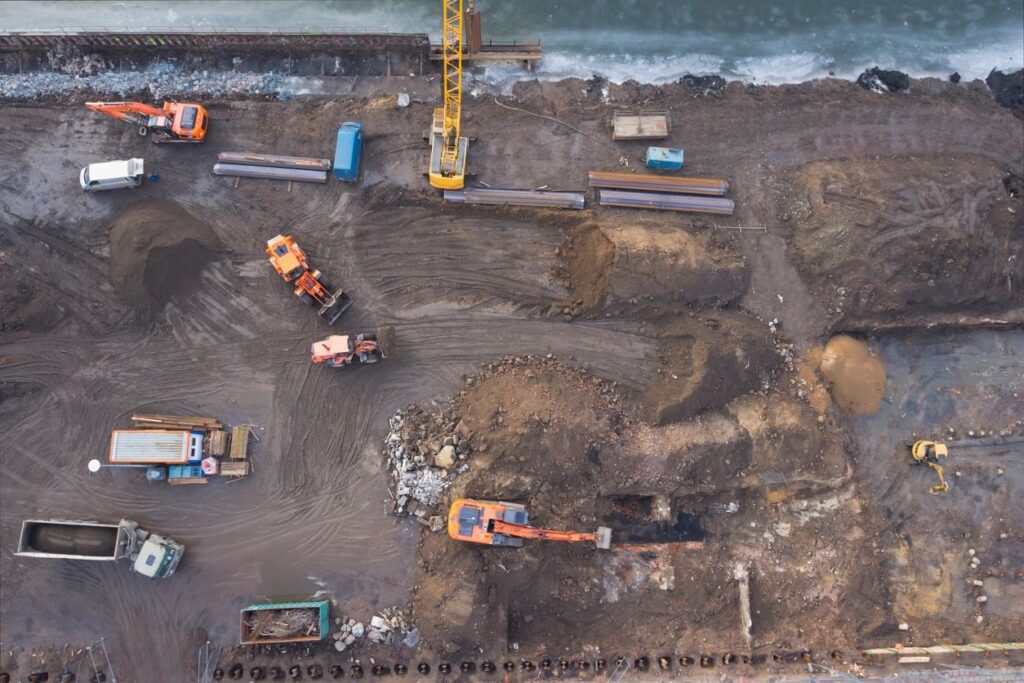Heavy Equipment & Traffic Control Safety: Essential Practices for Construction Sites

When you’ve got heavy equipment moving, vehicles coming in and out, and crews working around active zones—your safety risks spike. Whether it’s excavators, dump trucks, loaders, or subcontractors pulling up with deliveries, traffic control and equipment safety are among the most frequent sources of severe injuries on job sites. Getting this right isn’t just good practice—it’s required, it can save lives, and non-compliance can cost you huge.
Why It Matters
- High Risk of Severe Injury: Struck-by incidents involving heavy equipment (swings, back-ups, blind spots), as well as runovers, are among the leading causes of serious injury and fatality in the construction industry.
- Regulatory Pressure: Cal/OSHA (and federal OSHA) enforce strict standards around traffic control, equipment safety, spotters, safe movement, and visibility. Audits, inspections, and fines happen more often when something goes wrong.
- Project Delays & Liability: One accident can lead to shutdowns, investigations, insurance claims, lawsuits. Safe operations prevent these downstream costs.
- Crew Morale & Reputation: Workers want to feel safe. Companies known for good safety programs attract better labor, and avoid turnover or absenteeism caused by injury or fear.
Key Regulations & Standards (Cal/OSHA + Federal)
Here are some of the legal/regulatory elements you need to be aware of (not exhaustive; check latest regs for your locale / job):
- Requirements for traffic control plans: These include delineation of worker and vehicle zones, signage, barriers, warning systems, and possibly flaggers / spotters.
- Equipment safety: proper maintenance, inspection, guarding of moving parts, ensuring rollover protective structures (ROPS), falling object protection.
- Operator training / certification: Only trained and competent operators should move heavy machinery. Workers near equipment must be trained to recognize exposure hazards.
- Visibility & warning systems: backup alarms, spotters, mirrors, high-visibility clothing, lighting.
- Personal Protective Equipment (PPE): High visibility vests, hard hats, steel-toe boots, etc.
- Coordination among contractors/subcontractors: Multi-employer site responsibilities.
What Best Practices Look Like: On the Ground
Here’s how to operationalize traffic control and heavy equipment safety so you’re doing more than just checking a box.
1. Site Planning & Design
- Pre-planning traffic flows: Designate specific routes for heavy equipment, delivery trucks, and pedestrians to minimize crossings.
- Barriers and delineation: Use physical barriers (cones, guardrails, barricades), permanent or temporary fencing, grade separations.
- Signage: Clearly mark vehicle paths, speed limits, hazard zones. Signs both warning (e.g. “Equipment Operating”, “Truck Entrance”) and directive (e.g. “Stop”, “Yield”, “Flagger ahead”).
2. Equipment Safety & Maintenance
- Regular inspection & maintenance: Ensure machinery is inspected per manufacturer specs. Focus on brakes, steering, hydraulic systems, lighting, backup alarms.
- ROPS & falling object protection (FOPS): Ensure equipment is properly equipped. Operators need cabins / canopies that protect from rollovers or falling debris.
- Safe hitching, counterweights, load limits: Don’t overload, ensure weight balance, verify ground stability.
3. Visibility & Spotters
- Mirrors, cameras, backup alarms: Especially for equipment with blind spots. Backup alarms should be loud and distinctive. Cameras and proximity sensors help.
- Spotters / flaggers: When machines are backing up or in tight site conditions. Should be trained, equipped (vests, signal devices), and absolutely in clear view of the operator.
4. Worker Training & Roles
- Operator training & qualifications: Certifications, documented training records. Not just how to drive the machine, but how to spot hazards, how to safely approach equipment, how to deal with emergencies.
- Traffic control personnel training: Flaggers and traffic controllers need proper training, PPE, and protocols: where to stand, hand signals, radio communication, etc.
- All-crew awareness: Everyone on site should know the vehicle routes, safe zones, what to do if a machine is moving near them, etc.
5. Speed Control & Vehicle Movement
- Speed limits: Set reduced speed limits in active work zones.
- Clearances: Safe distance between equipment and workers. No surprises (e.g. sudden starts, swings).
- Movement protocols: Equipment should come to a full stop before picking up/dropping off people or materials. No workers standing under raised buckets or booms.
6. Communications & Signaling
- Two-way radios, hand signals: Clear communication is key when operator and spotter are not in direct line-of-sight.
- Visual signals: Use flags, lights, spotlights as needed.
- Emergency signals: Everyone should know what to do in a stop situation (whistle, horn, backup alarm).
Putting It Into Action: Your Safety Checklist
Here’s a practical checklist you can embed or distribute to make sure everything’s covered.
- Traffic flow plan drawn up and communicated
- Barriers, signage, delineation set up prior to work start
- All heavy equipment inspected, with maintenance logs up to date
- ROPS/FOPS in place, loads within capacity, counterweights correct
- Backup alarms, mirrors, visibility aids installed and functioning
- Spotters in place as needed; flaggers trained and visible
- Operators certified; workers trained for traffic control awareness
- PPE (vests, helmets, boots, etc.) for everyone on site
- Speed limit defined and enforced in site traffic routes
- Emergency communication protocol understood and available
Challenges & Pitfalls to Watch Out For
- Complacency around “routine” work: When equipment movements seem routine, crews slip up on vigilance.
- Poor site layout / tight spaces: When space is limited, blind spots magnify and risk increases.
- Lack of communication: Spotters or flaggers not clearly understood by equipment operators; mis-use of signals.
- Inadequate maintenance: Backup alarms out, mirrors broken, lights low—these small failures often lead to big incidents.
- Mixed employer responsibility: On large sites, overlaps between contractors/subcontractors must be clearly managed so everyone knows who’s responsible for signage, barriers, etc.
Conclusion & Take-Aways
Heavy equipment + traffic control safety isn’t glamorous, but it’s foundational. Getting it right:
- Protects lives, avoids injuries.
- Shields you from regulatory fines and liability.
- Saves money over time—avoided repairs, insurance, legal fees, downtime.
- Builds trust with crews and clients.

Leave a Comment